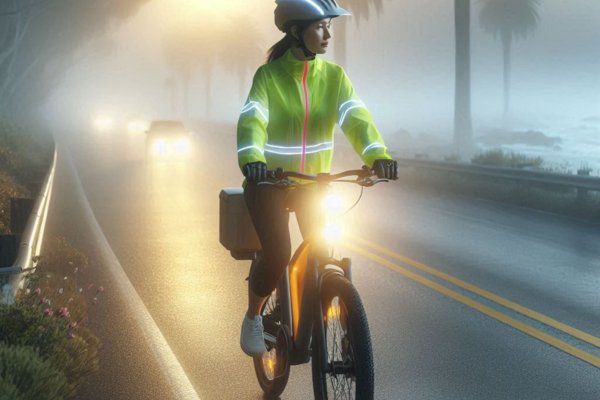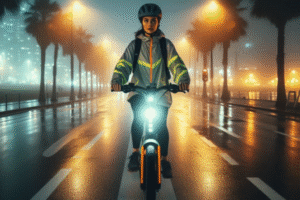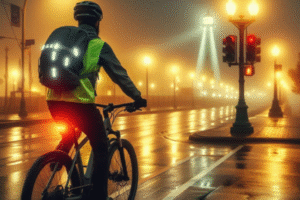🌫️ How to Stay Visible During Foggy Mornings on the Coast
Coastal mornings have a charm of their own: the quiet mist rolling over the boardwalks, the sound of waves in the distance, and the muted sunlight filtering through the fog. But for e-bike commuters, those early coastal hours can bring more than beauty—they bring risk. Fog is one of the most underestimated hazards for riders, especially when navigating through busy seaside roads where drivers, pedestrians, and cyclists share the space in reduced visibility.
In this guide, we’ll explore how to stay safe and highly visible while commuting through foggy coastal mornings. From lighting to posture, and gear to road behavior, you’ll learn practical strategies to make sure you’re seen by everyone—from distracted drivers to fellow cyclists emerging from the mist.
🌁 Understanding Coastal Fog and Its Impact
Fog forms when humid air cools rapidly, often occurring along coastlines where ocean breezes collide with warmer inland temperatures. It can roll in swiftly at dawn and remain dense for several hours, especially near harbors, river mouths, and coastal cliffs.
For e-bike commuters, this means several things:
- Reduced visibility: Fog can limit your field of view to 20–50 meters or less, making it hard to spot cars, cyclists, or road obstacles in time.
- Lower contrast: Neutral backgrounds like white buildings, pale sidewalks, and sea mist reduce how much you visually “pop” to others.
- Humidity effects: Moisture in the air can fog up glasses, mirrors, or even your e-bike’s display panel, adding to the challenge.
Drivers are also affected—they may not see you until it’s too late, especially if they’re distracted or unfamiliar with the area.
🚴♀️ Why Visibility Is More Than Just Lights
While many riders rely solely on their bike’s headlight, visibility in fog demands a more holistic approach. It’s about being seen from all angles, at all times—even by those who aren’t actively looking for you. This includes not only what you wear and how your bike is equipped, but also how you behave on the road.
- Layer your visibility tools: Combine lights, reflectors, and bright apparel for a 360° effect.
- Be proactive in your space: Don’t ride too close to the curb—stay in the line of sight.
- Make predictable movements: Fog limits reaction time, so sudden turns or swerves can be dangerous.
The goal is to ensure you’re noticed not just by drivers but by everyone sharing the coastal environment—from early joggers to delivery bikes on narrow seaside lanes.
💡 Tip: Coastal fog can appear even on sunny days after dawn. Always ride as if visibility will drop—being prepared protects you even when the sky looks clear.
In the next block, we’ll dive into the specific **lighting strategies** that work best in coastal fog, from beam positioning to battery backups. Because when it comes to visibility, **brightness is only part of the equation**—smart lighting is the real game changer.
💡 Light the Way: Smart Lighting Techniques for Foggy Coastal Rides
When it comes to fog, brightness alone is not enough. Coastal fog behaves differently than urban darkness—it scatters light, reflects beams back at you, and can create a halo effect that makes you harder to see, not easier. That’s why smart lighting—using the right lights, placed correctly, at the right settings—is the key to being noticed and staying safe during misty morning commutes.
🔦 Choose the Right Lights for Coastal Fog
All lights are not created equal, especially when riding near the sea. Foggy environments require a specific approach to illumination. Instead of focusing on the most powerful lumen count, prioritize beam shape and placement.
- Use a wide, low-mounted front beam: Lights mounted on the handlebars reflect off fog and can reduce visibility. Add a second light closer to the front axle or fork for ground-level projection.
- Install a flashing rear light: Red flashing lights are easier to detect through fog, especially in lower light levels before sunrise.
- Use side visibility tools: Spoke lights, frame reflectors, and wheel stripes make you visible when crossing intersections or riding in narrow boardwalk paths.
While high-powered lights may seem appealing, they often create a “white wall” in the fog, reflecting light back and reducing your ability to see ahead.
🔋 Battery Backup and Charging Habits
Humidity affects battery performance, and foggy coastal mornings are no exception. Always carry backup solutions and develop a routine that protects your lighting reliability.
- Charge lights fully the night before—don’t rely on last-minute plug-ins or partial charges.
- Carry a power bank with a USB output if you use rechargeable lights.
- Keep spare clip-on lights in your backpack or saddlebag—cheap, lightweight options can save you in an emergency.
Riders who commute through fog regularly should consider upgrading to **dynamo-powered lights** or **dual-light systems** that offer redundancy in case one fails mid-ride.
⚠️ Common Mistakes That Reduce Visibility in Fog
Even experienced cyclists make visibility mistakes in foggy weather. Avoiding these errors can drastically improve your visibility on coastal streets.
- Aiming lights too high: This creates glare and reduces depth perception.
- Using only a helmet light: It’s great for looking around, but insufficient for low-ground visibility.
- Overlooking side visibility: Most collisions at intersections come from side impact—not the front or rear.
💡 Tip: Mount your front light just above the front tire at a 10–15 degree angle toward the road. This creates better surface visibility without lighting up the fog.
Coming up next in Block 3, we’ll focus on your **clothing and gear**—because being visible isn’t just about your bike. The right outfit can be a lighthouse in the mist. 🚴♀️🌫️🦺
🧥 Dress to Be Seen: Visibility Clothing for Foggy Coastal Commutes
Visibility doesn’t stop at lighting—your clothing is a vital layer in your safety system. On foggy coastal mornings, your outline can easily blend into the scenery: muted boardwalk colors, pale sand tones, and gray skies create the perfect camouflage for someone wearing dark or neutral gear. That’s why e-bike commuters need to think like runners, hikers, or even rescue workers: wear to be seen.
👕 Choose High-Contrast Outerwear
The right jacket or top can make the difference between being noticed from 50 meters or disappearing into the mist. In fog, brightness and contrast are far more effective than fashion.
- Fluorescent colors: Neon yellow, orange, green, or pink are the most visible in foggy conditions and stand out in both daylight and low light.
- Avoid black or gray clothing: These colors disappear completely against wet pavement and marine haze.
- Go for layered color combinations: For example, wear a neon top over a darker base layer to create visual contrast and movement.
✨ Add Reflectivity in Motion
Reflective materials work best when in motion. Instead of relying only on a reflective strip on your backpack, add reflectivity in areas that move while you ride—this catches attention more effectively in fog.
- Ankle bands: As you pedal, reflective ankle straps move rhythmically, increasing detection.
- Helmet decals: Stick reflective tape around your helmet—especially on the sides and rear.
- Gloves or sleeve piping: Moving your arms while signaling is enhanced with reflective cuffs or designs.
Be sure that all reflective gear is clean and visible—fog can dampen and dirty surfaces quickly, reducing their effectiveness.
🎒 Accessory Visibility: Bags, Rain Covers, and Extras
Your backpack or pannier can either make you stand out or disappear completely. Use it to your advantage.
- Reflective rain covers: These protect your gear and increase surface visibility with neon color and reflective patches.
- LED clip-on lights: Attach them to straps, rear zippers, or backpack flaps for extra rear-facing light.
- Mirror reflectors: Add reflective tape to helmet mirrors or handlebar accessories for better 360° detection.
💡 Tip: Motion is visibility. Choose gear that moves with you and features reflectivity—your pedaling legs and signaling arms are your best safety signals in fog.
Next up in Block 4, we’ll focus on **riding techniques and behaviors** that make you not only visible, but also predictable and respected on foggy coastal roads. Because safety isn’t only about being seen—it’s about being understood. 🚴♀️🌫️🛣️
🛣️ Ride Predictably: Behavior and Positioning in Foggy Conditions
Even with great lights and the right gear, your riding style is what truly keeps you safe in fog. Visibility is not just about being bright—it’s about being readable. On foggy coastal mornings, drivers, pedestrians, and other cyclists all have limited visual and mental reaction time. That means your best defense is clear, confident, and steady movement that allows others to anticipate what you’ll do next.
📏 Positioning on the Road
Where you ride in the lane matters more than ever in low-visibility conditions. Hugging the curb or weaving between parked cars not only reduces your visibility but also makes your behavior harder to interpret.
- Maintain a straight line in the bike lane or on the shoulder—no swerving unless absolutely necessary.
- Take the lane when there’s no dedicated bike path and the road is narrow or visibility is poor.
- Stay away from the edge where parked cars may suddenly open doors or sand may accumulate from the shore.
Your position sends a message. Assertive riding says, “I’m here. I’m predictable. Share the road with me.”
👁️ Scan Constantly and Use Your Senses
In foggy conditions, vision is compromised, but sound often becomes more useful. You may hear a vehicle or voice before you see it. Maintain high alertness.
- Look further ahead than usual, even if details are blurry—early detection buys you time.
- Turn your head frequently to assess traffic and intersections.
- Don’t wear headphones—use your ears to hear approaching cars, other cyclists, or shouts from pedestrians.
Riding in fog is about tuning in with every sense. Vision leads, but hearing often saves.
✋ Use Clear, Big Signals
Hand signals in fog must be bold, high, and deliberate. A quick wave won’t do. Your arms are part of your visibility strategy—use them effectively.
- Signal turns at least 5 seconds in advance.
- Extend your arm fully and hold it steady for better recognition by others in low contrast.
- Make eye contact where possible—especially at crosswalks and intersections near tourist areas.
💡 Tip: Ride like a car: signal clearly, hold your lane, and behave predictably. In fog, uncertainty becomes danger. Be the steady presence others can rely on.
🧘♀️ Stay Calm and Ride with Flow
Fog makes everything feel slower—and that’s your cue to adjust pace, not push harder. Rushing in poor visibility can lead to overreactions and missed signals.
- Slow your average speed by 10–20% in dense fog.
- Give space to everyone—vehicles, pedestrians, and even other cyclists may not see you coming.
- Take breaks if the fog becomes overwhelming—especially if visibility drops below 20 meters.
You’re not just a cyclist—you’re a navigator. In foggy coastal cities, riding calmly and deliberately makes you safer, smarter, and a model for others who may be less prepared.
In the final block, we’ll wrap up with a powerful mix of FAQs, emotional reflection, and a call to the community. Because visibility isn’t just about surviving the fog—it’s about riding with intention. 💛🌫️🚴♀️
💬 Frequently Asked Questions (FAQs)
1. Are blinking lights better than steady ones in fog?
Yes, especially on the rear of your e-bike. Flashing red lights are more noticeable in low-contrast environments like fog. However, avoid high-speed strobe settings on your front light—use a steady or slow pulse to avoid creating glare in dense mist.
2. Should I use lights during the day if there’s only light fog?
Absolutely. Even light fog diffuses visibility and reduces contrast. Using lights during any degree of coastal fog helps others recognize your movement early—especially from the side or in peripheral view.
3. Can reflective tape alone make me visible enough?
Reflective tape is helpful, but not sufficient. It needs a light source to work—so if no headlights hit it, it’s not visible. Always combine reflectivity with active lighting and bright colors for a layered visibility approach.
4. Is fog worse near the beach than in inland areas?
Yes. Coastal fog tends to be thicker and more persistent, especially near harbors, estuaries, and sea-level roads. Temperature differences between land and sea intensify fog formation at dawn, so visibility is often lowest near the shoreline.
5. What should I do if visibility drops suddenly during my ride?
Slow down immediately, turn on all lights (including side-mounted ones), and consider pulling over if you can’t see more than 10–15 meters ahead. Visibility is not just for others to see you—you must also be able to see where you’re going.
💖 Final Thoughts: Visibility Is a Choice—and a Responsibility
Fog teaches us humility. It softens the world, quiets the city, and reminds us that presence matters more than speed. On your e-bike, you become part of that environment—not fighting it, but flowing through it with awareness, light, and purpose.
Every time you choose to prepare, to light up, to reflect, to signal—you’re choosing to respect the community, the rhythm of the morning, and your own journey. Visibility isn’t vanity. It’s responsibility. It’s life. And it’s how we create safer paths not just for ourselves, but for every rider after us.
💡 Tip: Visibility in fog isn’t about being the brightest. It’s about being the clearest. The rider who shines with intention is the one who leads through the haze.
🌍 Share Your Fog-Riding Wisdom
Are you a seasoned early-morning coastal commuter? Do you ride through fog along the harbor, up seaside hills, or through damp residential neighborhoods? Your experience could help others stay safer in their own misty journeys.
Tell us in the comments:
🌫️ What’s your best visibility trick for foggy rides?
🧥 What gear or lights do you swear by?
🚴♀️ What moment taught you the importance of being seen?
Together, we ride smarter, safer, and brighter—no matter how thick the fog may be. 💛🚲🌁



